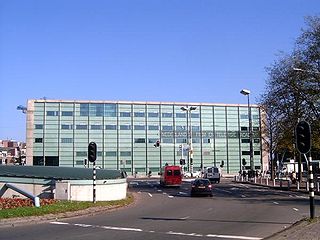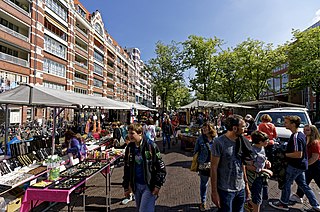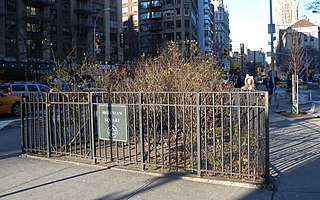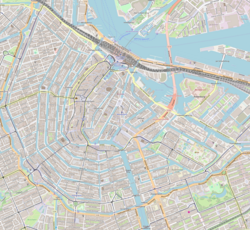
Amsterdam is the capital and most populated city of the Netherlands. It has a population of 1,182,000 in 2024 within the city proper, 1,457,018 in the urban area and 2,480,394 in the metropolitan area. Located in the Dutch province of North Holland, Amsterdam is colloquially referred to as the "Venice of the North", for its large number of canals, now a UNESCO World Heritage Site.

The Upper West Side (UWS) is a neighborhood in the borough of Manhattan in New York City. It is bounded by Central Park on the east, the Hudson River on the west, West 59th Street to the south, and West 110th Street to the north. The Upper West Side is adjacent to the neighborhoods of Hell's Kitchen to the south, Columbus Circle to the southeast, and Morningside Heights to the north.

The Netherlands Film Academy (NFA) was founded in 1958.

Lincoln Square is the name of both a square and the surrounding neighborhood on the Upper West Side of Manhattan in New York City. Lincoln Square is centered on the intersection of Broadway and Columbus Avenue, between West 65th and 66th streets. The neighborhood is bounded by Columbus and Amsterdam avenues to the east and west, and 66th and 63rd streets to the north and south, respectively. However, the term can be extended to refer to the neighborhood between 59th and 72nd streets. It is bounded by Hell's Kitchen, Riverside South, Central Park, and the Upper West Side proper. The Walt Disney Company’s New York City campus is located here, including ABC News, ESPN, Hulu, and studios for WABC-TV.

The Lincoln Square Synagogue is a Modern Orthodox congregation and synagogue located at 180 Amsterdam Avenue between West 68th and 69th Streets in the Lincoln Square neighborhood of Manhattan, New York City.

Waterlooplein is a square in the centre of Amsterdam in the Netherlands. The square near the Amstel river is named after the Battle of Waterloo in 1815. Prominent buildings on the square are the Stopera city hall and opera building and the Mozes en Aäronkerk church.

In the Jewish diaspora, a Jewish quarter is the area of a city traditionally inhabited by Jews. Jewish quarters, like the Jewish ghettos in Europe, were often the outgrowths of segregated ghettos instituted by the surrounding Christian or Muslim authorities. A Yiddish term for a Jewish quarter or neighborhood is "Di yiddishe gas", or "The Jewish quarter." While in Ladino, they are known as maalé yahudí, meaning "The Jewish quarter".

Sherman Square is a pocket park bounded by Broadway, Amsterdam Avenue, and West 70th Street on the Upper West Side of Manhattan, in New York City. It was named in 1891 for William Tecumseh Sherman who lived in the area and died that year.

The Zwanenburgwal is a canal and street in the center of Amsterdam. During the Dutch Golden Age the canal was home to painter Rembrandt van Rijn, as well as philosopher Spinoza lived here. In 2006 it was voted one of the most beautiful streets in Amsterdam by readers of Het Parool, a local daily newspaper.

In the early modern era, European Jews were confined to ghettos and placed under strict regulations as well as restrictions in many European cities. The character of ghettos fluctuated over the centuries. In some cases, they comprised a Jewish quarter, the area of a city traditionally inhabited by Jews. In many instances, ghettos were places of terrible poverty and during periods of population growth, ghettos had narrow streets and small, crowded houses. Residents had their own justice system. Around the ghetto stood walls that, during pogroms, were closed from inside to protect the community, but from the outside during Christmas, Pesach, and Easter Week to prevent the Jews from leaving at those times.

Indische Buurt is a neighborhood in the borough of Oost, the eastern part of the city of Amsterdam, Netherlands. The name of the neighborhood dates from the early 20th century, and is derived from the fact that the neighborhood's streets are named after islands and other geographical concepts in the former Dutch colony of the Dutch East Indies or now known as Indonesia. The first street was named in 1902.

Jews comprise approximately 10% of New York City's population, making the Jewish community the largest in the world outside of Israel. As of 2020, over 960,000 Jews lived in the five boroughs of New York City, and over 1.9 million Jews lived in the New York metropolitan area, approximately 25% of the American Jewish population.

Amsterdam-West is a borough of Amsterdam, Netherlands, to the west of the centre of the city. This borough was formed in 2010 through the merging of four former boroughs Oud West, Westerpark, De Baarsjes and Bos en Lommer.
The Jodenbuurt is a neighbourhood of Amsterdam, Netherlands. For centuries before World War II, it was the center of the Dutch Jews of Amsterdam — hence, its name. It is best known as the birthplace of Baruch Spinoza, the home of Rembrandt, and the Jewish ghetto of Nazi occupation of the Netherlands.

Rivierenbuurt is a neighbourhood of Amsterdam, Netherlands. The neighbourhood is situated in the eastern part of the borough of Amsterdam-Zuid, bordered by the river Amstel to the east, the Boerenwetering canal in the west, the Amstelkanaal in the north and the A10 motorway in the south. In 2013, the Rivierenbuurt had approximately 28,400 residents.

As of 2020, the Jewish population in New York State was 1,598,000, accounting for 21% of all Jews in the United States. In New York City alone, there are approximately 960,000 Jews, establishing it as the largest Jewish community in the world, surpassing the combined totals of Tel Aviv and Jerusalem.

The Houtkopersburgwal is a short secondary canal in Amsterdam. It is located in the east of the Amsterdam-Centrum district in the Lastage neighborhood.

The Snoekjesgracht is a small canal in Amsterdam, in the Lastage neighborhood.


















